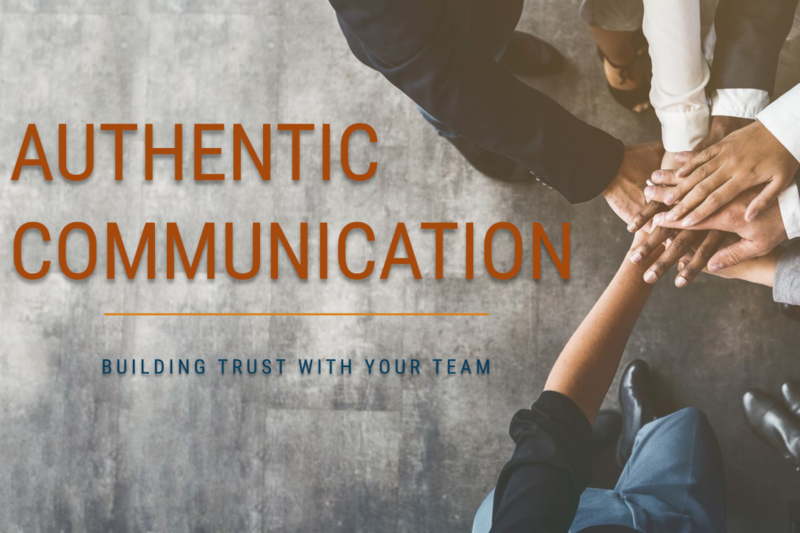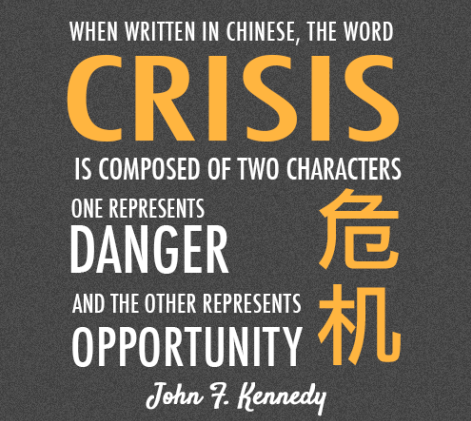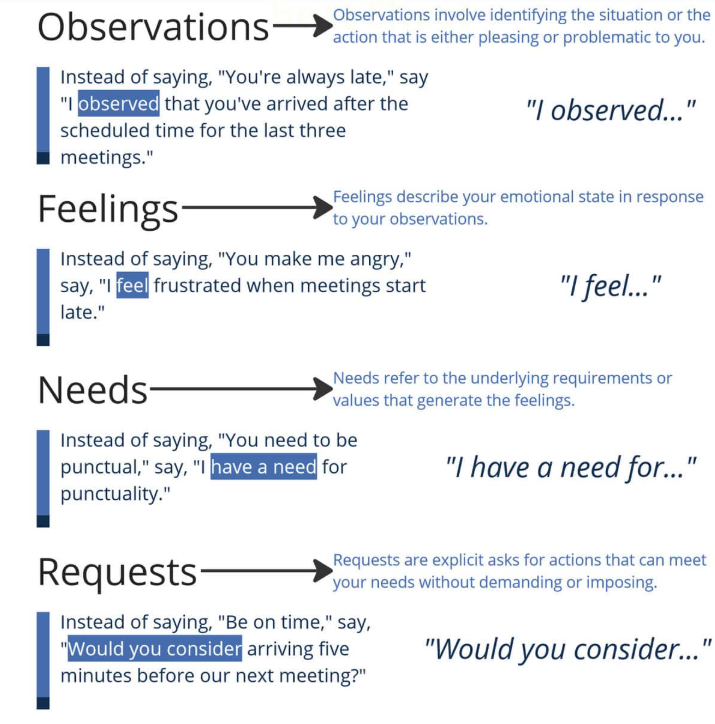Authentic Communication: A Leader's Guide to Difficult Conversations
In today's complex business landscape, the differentiator between good organizations and extraordinary ones isn't found in strategy documents or operational excellence alone. It lies in how leaders transform tension into forward momentum—how they convert difficult conversations into catalyst moments for innovation and growth.
This Authentic Communication framework provides research-backed strategies to:
- Transform high-stakes conflicts into collaborative breakthroughs
- Access opportunities hidden within emotionally charged moments
- Build psychological safety that drives innovation and performance
- Master the four essential elements of transformative communication
- Implement practical applications tailored to your leadership context
The Communication Imperative: Why This Matters Now
Leaders today face unprecedented communication challenges:
- Distributed Teams: Remote and hybrid work has fundamentally altered conversation dynamics
- Accelerating Change: Navigating uncertainty demands transparent, trust-based communication
- Diverse Workforces: Multiple generations and cultural backgrounds require adaptive approaches
- Complex Problems: Today's challenges require cross-functional collaboration
- Talent Expectations: Top performers expect authentic leadership and meaningful connection
According to McKinsey research, leaders now spend up to 80% of their time communicating, yet only 14% report feeling "very satisfied" with their communication effectiveness—a gap representing both significant challenge and tremendous opportunity.
Like the concert grand piano that transforms 40,000 pounds of string tension into beautiful harmony, leaders who master authentic communication can harness the energy in difficult conversations to create alignment, innovation and breakthrough thinking. This framework shows you how.
The Power of Authentic Communication in Business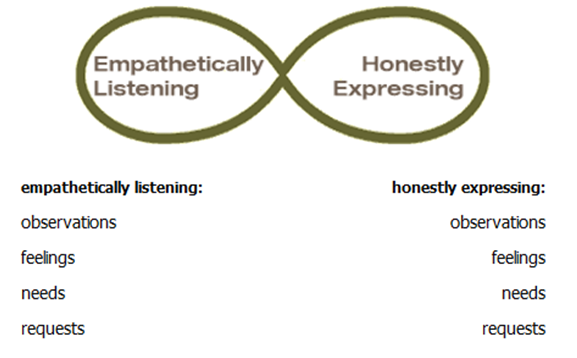
the dual path to connection
Authentic communication offers two fundamental paths toward meaningful connection:
- Honest Expression: Respectfully sharing your feelings and needs
- Empathic Listening: Being fully present to others' experiences without judgment
These choices represent a radical departure from our conditioned responses to conflict—fight, submit or flee. When we frame communication as either expressing our truth or deeply listening to others, we create new possibilities for breakthrough solutions.
the emotional intelligence foundation
At the heart of authentic communication lies a powerful balance of two emotional intelligence subscales:
- Empathy creates psychological safety and builds connection through understanding others' perspectives, feelings, and needs
- Assertiveness ensures your perspective contributes to the solution through clear expression of observations, feelings and requests
This balance is crucial: Assertiveness without empathy becomes aggression; empathy without assertiveness leads to accommodation that fails to address important issues. By strategically balancing empathy and assertiveness, leaders can transform workplace communication from control to collaboration, creating environments where breakthrough thinking thrives and measurable business results follow.
measurable business outcomes
Authentic communication transforms both workplace dynamics and measurable business outcomes:
- Teams with high psychological safety outperform others by 23% (Google's Project Aristotle)
- Companies with effective communication are 50% more likely to report below-average turnover (Towers Watson)
- Organizations with leaders skilled in authentic communication show 21% higher profitability (Gallup)
As workplace researcher Steve Bates documented, "study after study indicates that employee emotions are fundamentally related to—and actually drive—bottom-line success in a company."
two communication paradigms
controlling Communication
- Operates from a consciousness of domination
- Prioritizes being right and controlling others
- Uses moral judgments (good/bad, right/wrong)
- Motivated by external rewards/punishments
- Creates compliance through directives
- Establishes hierarchical relationships (power over)
- Focuses on past behaviors or future events
collaborative Communication
- Operates from a consciousness of partnership
- Prioritizes connection and shared understanding
- Uses life-serving judgments (needs met/unmet)
- Motivated by intrinsic feelings/needs
- Creates alignment through mutual commitment
- Establishes mutual relationships (power with)
- Focuses on the present moment opportunities
The authentic communication framework helps leaders shift from controlling to collaborative communication patterns, transforming organizational dynamics from compliance to commitment.
the "four ears" framework
We have four distinct ways of "hearing" difficult messages:
- Blaming Others (Attacking) - Responding with counter-criticism or defense
- Blaming Ourselves (Submitting) - Taking responsibility for others' feelings
- Sensing Our Own Feelings & Needs - Connecting to what's alive in us
- Sensing Others' Feelings & Needs - Empathically connecting to others
The first two "ears" perpetuate conflict through controlling communication. The second two create connection through collaboration. Skilled leaders consciously choose which "ear" to listen with in any given moment.
the neuroscience of communication
During difficult conversations, our brains activate neural pathways associated with physical danger:
- Reduced prefrontal cortex activity (rational thinking)
- Heightened amygdala response (emotional reactivity)
- Decreased oxytocin (trust hormone)
- Increased cortisol (stress hormone)
The authentic communication framework counteracts these stress responses by creating psychological safety—consistently shown to be the primary predictor of team performance.
The Authentic Communication Framework: Four Essential Elements
Adapted from Marshall Rosenberg's Nonviolent Communication approach, this framework provides a practical methodology for transforming workplace conflict into collaborative problem-solving:
Step 1: Observation Without Judgement
Traditional approach: "You're being unreasonable about the budget cuts."
Authentic approach: "When you raised your voice and stated three times that the budget proposal is unacceptable..."
Observations describe only what could be captured on video or audio—specific behaviors, words and actions—without attributing meaning or intent. This creates a shared reality both parties can acknowledge. If you combine observation with evaluation, people tend to hear critisism.
“The ability to observe without evaluating is the highest form of intelligence”―Marshall Rosenberg, Nonviolent Communication
An observation is something that you actually saw or heard in the past. You can think of it as raw information. The majority of observations fall into two categories: (i) what you heard, e.g., direct quotes, and (ii) what you saw, e.g., visible past behaviours.
Our brains are hardwired to take raw information and instantly make up a simple story — good or bad, right or wrong, hero or villain. These stories are evaluations and they are very hard to separate from observations.
Here are a few examples to illustrate the difference:
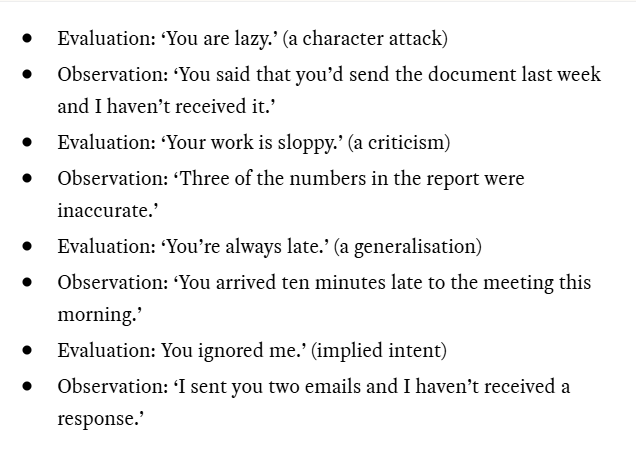
An easy way to check whether you’ve made an observation or an evaluation is to ask yourself, ‘What did I actually see or hear?
Step 2: Authentic Expression of Feelings
Traditional approach: "I feel like you're undermining my department."
Authentic approach: "I feel frustrated and concerned."
True feeling expressions name emotional states rather than thoughts or interpretations about what others are doing. Feelings are the bodily sensations that arise from our interpretations of stimuli—descriptions of what is happening inside you.
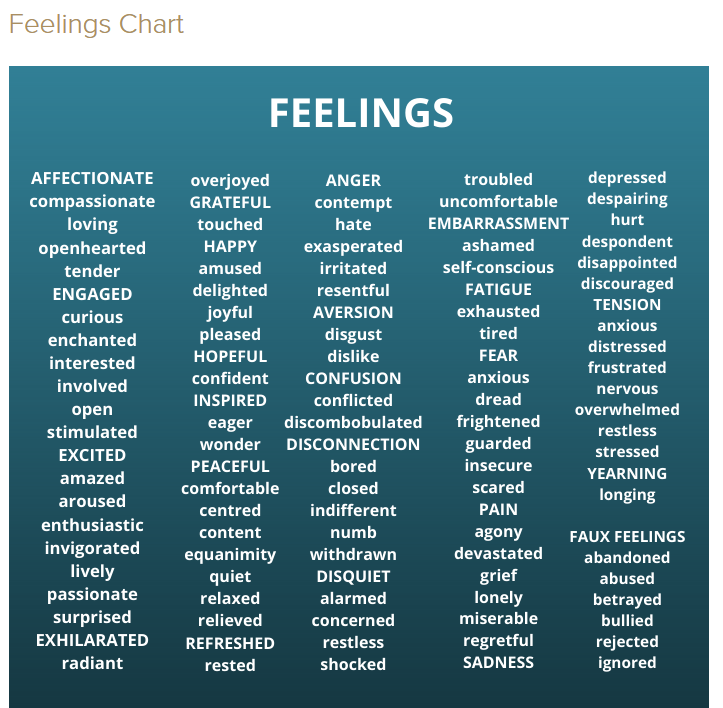
True feelings when needs are met include:
- Connection-related: appreciative, friendly, warm, grateful, trusting
- Energy states: energized, engaged, curious, enthusiastic
- Well-being states: content, peaceful, joyful, confident
- Clarity states: clear, determined, hopeful, relieved
TRUE feelings when needs remain unfulfilled include:
- Discomfort & unease: concerned, anxious, uncomfortable, overwhelmed
- Disconnection states: lonely, distressed, embarrassed
- Energy depletion: tired, lethargic, bored
- Emotional pain: sad, disappointed, hurt
- Mental distress: confused, frustrated, hesitant
- Intensity states: angry, alarmed, afraid
Pseudo-feelings
Pseudo-feelings are evaluative words often confused with feelings. These express an evaluation of someone else's behavior and typically carry a message of wrongness or blame.
How to Identify Pseudo Feelings
Check if you use these sentence patterns:
- "I feel that..."
- "I feel as if..."
- "I feel you (I, she, he, they)..."
- "I feel like..."
- If you can substitute ‘I feel’ with ‘I think’ and the phrase still works, it’s a thought, not an emotion.
Common Pseudo Feelings Examples:
- "I feel manipulated" (interpretation that someone is controlling you)
- "I feel ignored" (judgment that someone should pay attention to you)
- "I feel rejected" (interpretation of another's action as personal dismissal)
- "I feel disrespected" (interpretation that someone acted without proper regard)
- "I feel misunderstood" (judgment about another's failure to understand)
- "I feel insulted" (interpretation that someone intended to offend you)
- "I feel like you don't care" (thought about another's intentions)
- "I feel that this is unfair" (evaluation of a situation)
- "I feel like a failure" (self-judgment rather than emotion)
- "I feel that you're wrong" (evaluation of another's position)
Step 3: Connecting to Universal Needs
Traditional approach: "We need more marketing staff" vs. "We need to reduce personnel costs"
Authentic approach: "I'm concerned about our ability to successfully launch the new products (need for achievement) while you're worried about our financial sustainability (need for security)."
All human beings share the same universal needs. Every action we take represents an attempt to fulfill those universal human needs. When workplace conflicts arise, participants typically debate surface-level positions without exploring the deeper needs driving those positions.
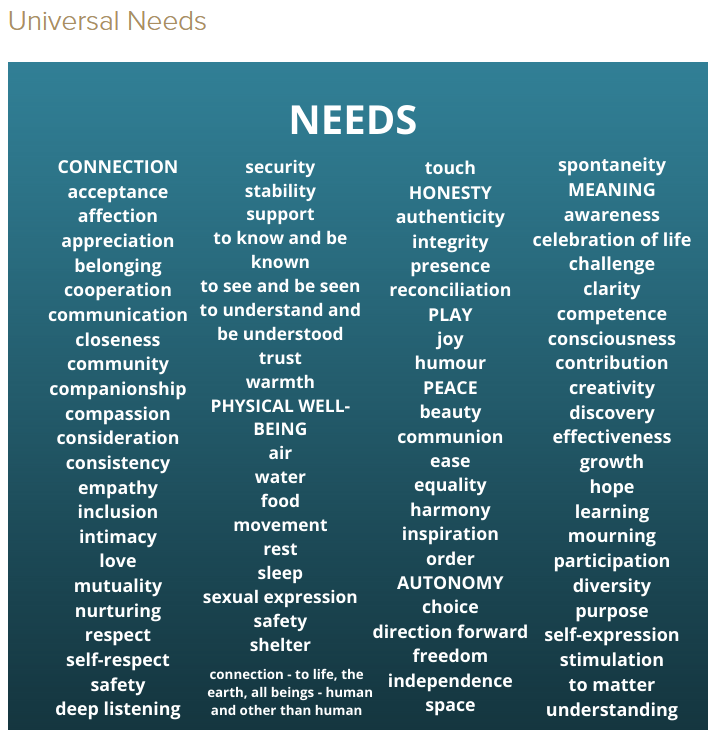
The pairing of emotions with universal needs has a transformative effect in difficult conversations. When conflicting parties recognize shared needs beneath seemingly incompatible positions, previously invisible solutions often emerge.
Universal Needs vs Strategy
In leadership conversations, precision matters. When we say, "I need," we often confuse universal human needs with specific strategies for meeting those needs. This distinction is critical for breakthrough communication.
Not everything that follows the words "I need" represents a universal need. For example, saying "I need a sandwich" doesn't mean sandwiches are a universal need. Rather, eating a sandwich is a strategy to meet your universal need for nourishment.
In workplace conversations, this distinction becomes even more important:
- Strategy: "I need you to copy me into every email."
- Universal Need: "I need transparency."
Removing Blame from Need Statements
There's a subtle but powerful shift that happens when we keep our need statements truly universal. As soon as you include "from you" in the need statement, it stops being universal and can trigger defensiveness. Compare:
- Strategy/Demand: "I need support from you."
- Universal Need: "I need support."
The first statement can be interpreted as a veiled accusation: "You aren't supporting me." To minimize defensive reactions and create psychological safety in your team, leave other people out of your need statements.
The Breakthrough Potential
For leaders, identifying universal needs creates powerful options. Once you uncover the universal need beneath a specific request, you can identify multiple strategies that might meet everyone's needs simultaneously.
This approach shifts conversations from positional bargaining ("do it my way") to collaborative problem-solving ("how might we meet everyone's needs?"). It transforms potential conflict points into catalyst moments where innovative solutions emerge.
Step 4: Making Requests versus Demands
Traditional approach: "You need to postpone these cutbacks immediately."
Authentic approach: "Would you be willing to delay staffing decisions until after we launch the new product line?"
What is the difference between a request and a demand? Both are strategies that would meet an unmet need. But unlike demands, requests are invitations for the other person to meet our needs . . . but only if it isn’t in conflict with one of their needs. Authentic requests clearly articulate specific, actionable behaviors while remaining open to hearing "no" and exploring alternatives. This fundamentally differs from demands, which typically produce only compliance or rebellion.

1. Make It Specific
Vague requests create confusion and misalignment. "I request that you be more respectful" leaves interpretation wide open—what signals respect to you may not signal respect to others.
Instead: Spell out concrete, observable behaviors that would meet your need: "I request that you arrive at meetings five minutes early so we can start on time."
2. Say What You Want, Not What You Don't Want
Stating what you don't want creates a vacuum without direction. "Don't dismiss other people's ideas straightaway" explains what to avoid but fails to provide a path forward.
Instead: Clarify the specific behaviors you want to see:
- "When a team member shares an idea, I request that you ask two or three probing questions before sharing your conclusion."
- "I request that you begin your response with one aspect of the idea you find valuable before offering challenges."
3. Stay Curious When Facing Resistance
Remember that multiple strategies can satisfy your underlying needs. When someone says "no" to your request, treat it as valuable information rather than rejection.
Instead of pushing harder: Explore the needs preventing agreement:
- "Help me understand what concerns you about this request."
- "What would need to change about this request for you to say yes?"
Confirming Understanding
Even simple requests like "I'd like you to be on time for the next meeting" carry unintended meanings depending on context, tone and history.
To ensure alignment, diplomatically check for understanding:
- "Just so we're on the same page, could you play back what I'm asking of you?"
- "To make sure I've been clear, would you mind sharing how you plan to approach this?"
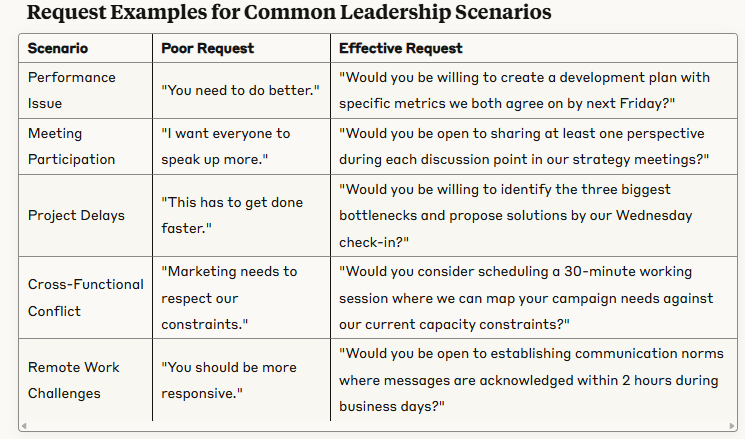
Implementation: Making Authentic Communication Your Leadership Practice
Starting Small: Daily Practice Opportunities
Begin by focusing on one element of the framework in everyday interactions:
- Practice making clean observations without judgment
- Develop vocabulary for naming feelings accurately
- Identify the needs behind your own reactions
- Formulate clear requests instead of complaints
Self-Empathy: The Foundation of Authentic Leadership
One crucial element often overlooked is self-empathy—the practice of connecting with your own feelings and needs before engaging with others. Self-empathy creates the internal spaciousness needed for effective self-regulation and decision-making, particularly during challenging situations.
Creating this inner space involves:
- Pausing to notice body sensations, thoughts, feelings, and needs
- Approaching yourself with compassion rather than judgment
- Recognizing that all feelings provide valuable data about needs
- Taking responsibility for your own emotions rather than blaming others
- Making conscious choices about how to respond
Authenticity With Dignity
True workplace authenticity isn't about unfiltered expression but honest sharing without blame. Effective leaders balance candor with care, transforming potentially damaging exchanges into catalyst moments for growth.
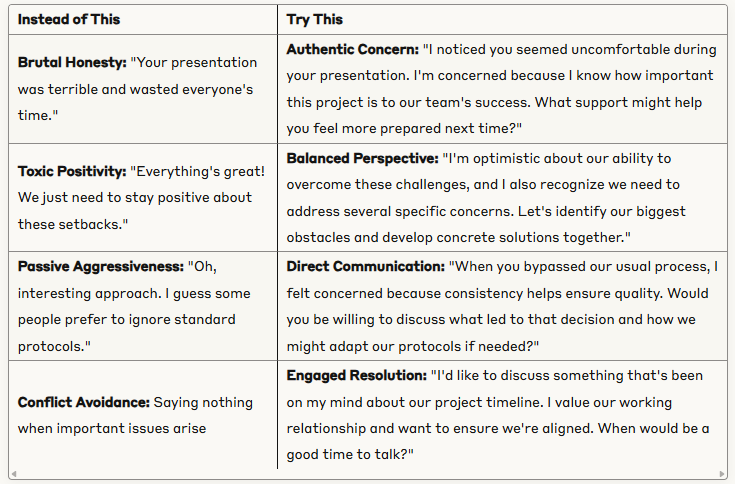
The most effective leaders understand that true authenticity requires thoughtful expression rather than unprocessed reactions. By pausing between stimulus and response, you create space for both honesty and dignity—transforming what could be destructive tension into productive energy.
When you communicate with both authenticity and dignity, you model the balance of empathy and assertiveness that creates psychological safety—the foundation for innovation, engagement, and breakthrough thinking in your team.
The Leadership Communication Advantage
When you approach tension as creative energy rather than problematic friction, you unlock unprecedented potential. The confluence of diverse perspectives through authentic dialogue generates powerful momentum—like tributaries forming a river that carries your organization forward.
In a business environment where connection increasingly determines competitive advantage, leaders who develop authentic communication skills:
- Transform everyday tensions into catalysts for breakthrough thinking
- Create environments where people bring their full capabilities to work
- Build cultures where disagreement fuels growth rather than division
- Establish the trust foundation required for sustainable, long-term success
Your Leadership Legacy
The most influential leaders understand that authentic communication isn't just a soft skill—it's the essential infrastructure for creating workplaces where both people and profits flourish. By embracing these principles, you position yourself and your organization to navigate complexity with confidence and transform challenges into opportunities for collective achievement.
Remember that each difficult conversation presents a choice: Will you defuse the tension and miss the catalyst moment, or will you harness that energy to create transformation? The leaders who consistently choose the latter don't just build successful teams—they create legacies of breakthrough thinking that endure long after they've moved on.
The piano strings of organizational tension are already there. The question is: Will you be the leader who transforms that tension into harmony?
This framework is adapted from Marshall Rosenberg's Nonviolent Communication approach and integrates current leadership research on emotional intelligence, psychological safety and high-performing teams.

